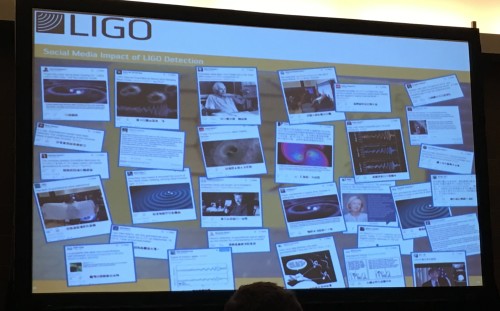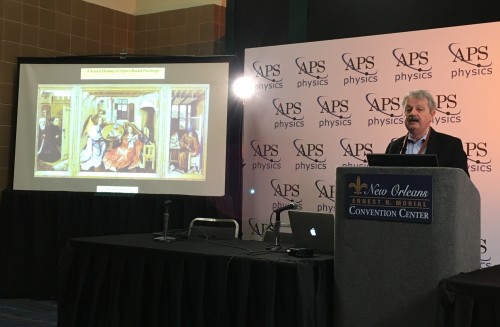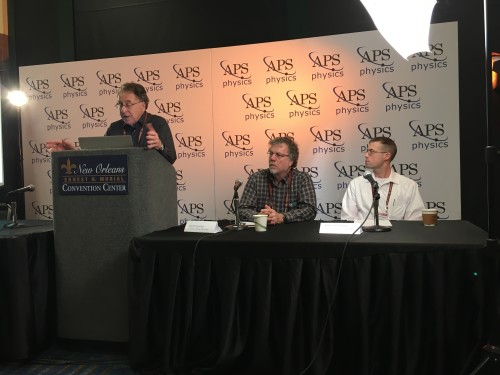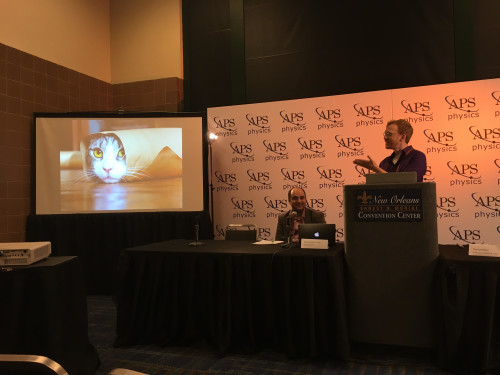Category Archives: APS March Meeting 2017
How LIGO got the word out about gravitational waves

Tweeting to millions: LIGO made a social-media plan before announcing the detection. (Courtesy: Sarah Tesh)
By Sarah Tesh
Nowadays, social media plays a big role in communicating science to the public. It has two important qualities – it’s free and it’s international. A great case study for social media and science came last year when the Laser Interferometer Gravitational-Wave Observatory (LIGO) announced the first ever detection of gravitational waves. To tell us more about how the team grabbed the public’s attention (and got its work on Sheldon Cooper’s T-shirt in The Big Bang Theory), LIGO scientist Amber Stuver gave a witty talk at the APS March Meeting 2017 about the outreach strategy.
She began by telling us the story of that exciting detection day. Before the first detection, LIGO had published 80 papers on “detecting nothing”. Yet on 14 September 2015 – the first morning of the first day of Advanced LIGO – the much-sought-after signal appeared. The first thing that had to be done was to check it wasn’t a fake. Having detected nothing for so long, those with the knowledge to do so would sometimes “inject” results to check the system worked and keep the scientists on their toes.
View all posts by this author | View this author's profile
Google’s ‘supreme’ 20-qubit quantum computer
By Tushna Commissariat in New Orleans, Louisiana, US
“We should have a 20-qubit chip ready very soon… in the next two months most likely,” says Google’s John Martinis to me as we lean against a wall in a relatively quiet corner of the sprawling convention centre in New Orleans. Martinis, a tall man with a mop of silver hair and an Alan Alda-esque manner, is very busy and I’m lucky to have caught him. Earlier that day, he gave one of the APS March Meeting‘s most popular talks on “quantum supremacy: checking a quantum computer with a classical supercomputer”. Martinis, whose team is based at the University of California Santa Barbara, spoke about how they are working towards developing a “scientifically and commercially useful quantum computer” made up of 50 qubits – a 7 by 7 array of superconducting qubits (each of which is coupled to its nearest neighbour) that can be programmed with a one or two-qubit gate – which has an error rate of about 0.1% and can actually do quantum computations.
View all posts by this author | View this author's profile
Physics reveals the mysteries behind art

Artists’ secrets: Charles Falco describes how artists used optical lenses. (Courtesy: Tushna Commissariat)
By Sarah Tesh in New Orleans, Louisiana, US
As a physicist who likes to sketch and paint, I love it when art and physics come together. I was therefore excited to see that the APS March Meeting had a variety of talks on the subject. Charles Falco from the University of Arizona in the US told us about his work with the famous artist David Hockney. On a trip to see the 15th century painting The Arnolfini Marriage by Jan van Eyck, Hockney decided that the chandelier was too detailed to have been done freehand. So Falco and Hockney began looking at the intricate parts of paintings by artists through the ages and found that they essentially cheated.
Through focal length and depth-of-field calculations, Falco showed that artists had used optical lenses to project the complicated parts onto the canvas before painting them. They suggest that this has been happening since the 1400s and is a technique used by artists such as Hans Holbein (who painted the iconic portraits of Henry VIII) and Johannes Vermeer (whose work includes Girl with a Pearl Earring). Obviously, they still possessed huge amounts of skill, but it definitely makes me feel a bit better about my own skill level.
View all posts by this author | View this author's profile
Invisible robots overshadowed by metallic hydrogen

Metallic debate: Silvera, Ceperley and McMahon discuss metallic hydrogen. (Courtesy: Sarah Tesh)
By Sarah Tesh in New Orleans, Louisiana, US
After much coffee and a lot of crispy bacon, the second day of the APS March Meeting began. The hot topic of the day – metallic hydrogen. Even though we arrived 15 minutes early to Isaac Silvera‘s talk, the crowd was overflowing from the room, but despite all the pushing and shoving (my foot has not recovered from being stood on), we did manage to get seats. Silvera began by saying that he had been working on the problem for “probably longer than [most of us] were born” before taking us through the nearly 45 years of research on the subject. He also gave a press conference that included talks by theoretical physicists David Ceperley from the University of Illinois and Jeffrey McMahon from Washington State University. My colleague Tushna Commissariat caught up with Silvera later on, so be on the lookout for a more detailed update from her.
View all posts by this author | View this author's profile
APS sees friction as fracture, cat pictures and brain implants

Cats and DFT: Thomas Baker chats about machine learning and density functional theory. (Courtesy: Sarah Tesh)
By Sarah Tesh in New Orleans, Louisiana, US
So the first day of the APS March Meeting has been and gone and the second is nearly at an end. Being my first conference as a journalist not a scientist, I was definitely as nervous as some of the speakers looked. The conference centre is huge, there are thousands of people and almost as many talks – a rather daunting prospect for a newbie. Thankfully there were some very interesting press talks, covering a variety of topics.
The first session began with Jay Fineberg from the Hebrew University of Jerusalem in Israel talking about “friction as fracture”. While we all learn about friction at school, the fundamental physics behind it remains shrouded in mystery. So Fineberg looks at the problem as the fracture of contact points. This approach makes it particularly useful for studying the motion of tectonic plates and, so, earthquakes. As Fineberg points out, seismologists have no idea about conditions deep in the ground at a fault. He and his team therefore hope to work out “what makes earthquakes tick”.
View all posts by this author | View this author's profile
Physicists take over the Big Easy

New Orleans: city with a view. (Courtesy: Tushna Commissariat)
By Sarah Tesh and Tushna Commissariat in New Orleans, Louisiana, US
It is that time of the year again when around 10,000 physicists gather for the American Physical Society (APS) March Meeting and this year we’re in the Big Easy. While yesterday was a jetlag-recovery day, it’s all kicking off today at the sprawling Ernest Morial Convention Center, where more than 9600 papers will be presented during the week.
Despite our sleep-deprived state yesterday, we played the traditional game of “spot the physicist” during our wanderings in the French Quarter. This was made particularly interesting with the simultaneous game of “spot the spring-breakers”. Relaxed, youthful students chatting loudly about their late-night escapades were a stark contrast to academics looking anxious and lost while over-burdened with poster tubes, suitcases and laptop bags.
View all posts by this author | View this author's profile
